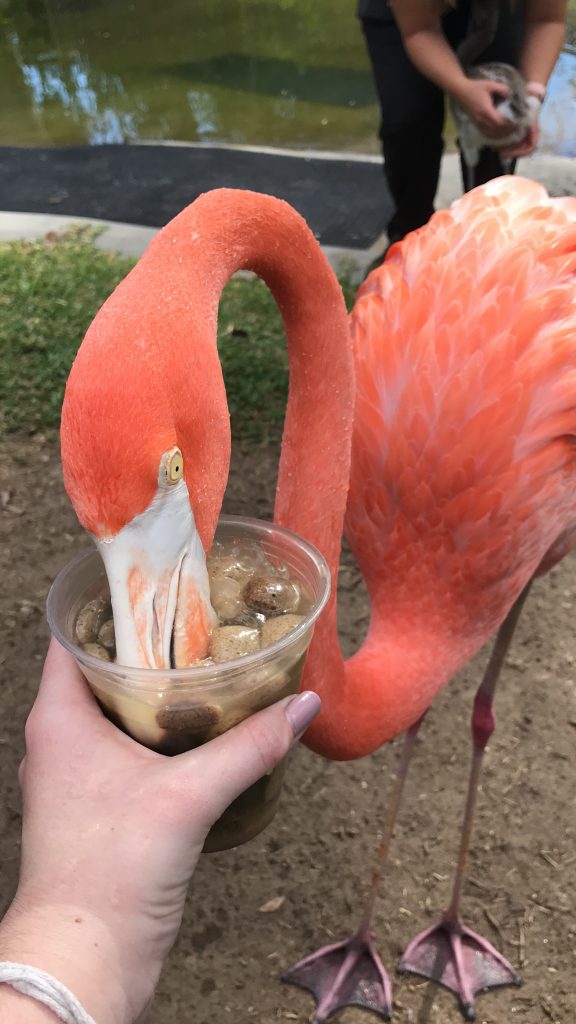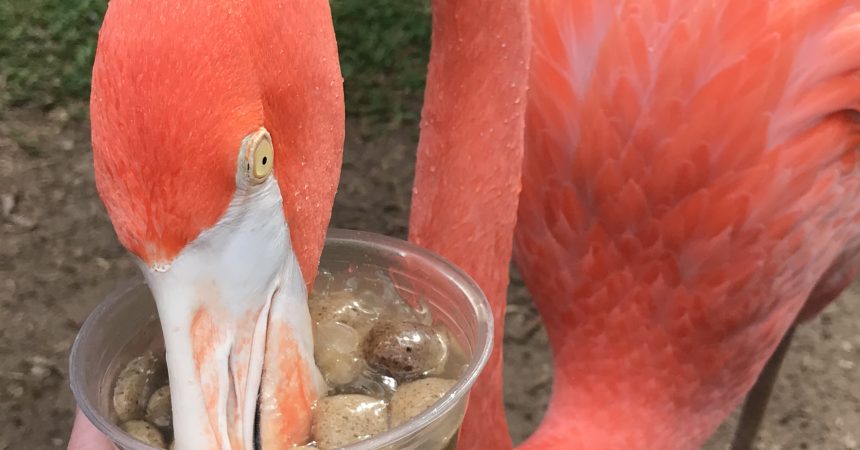Zoo InternQuest is a seven-week career exploration program for San Diego County high school juniors and seniors. Students have the unique opportunity to meet professionals working for the San Diego Zoo, Safari Park, and Institute for Conservation Research, learn about their jobs, and then blog about their experience online. Follow their adventures here on the Zoo’s website!
 During the first week of Zoo InternQuest, we met with a Lead Animal Trainer for the San Diego Zoo’s Animals in Action Program, Kelly Elkins. She took us on a quicker version of the premium experience that is available for Zoo guests. During this program, we fed flamingos, touched a Grant’s zebra, and watched a cheetah cub training. This allowed for us to get an inside look into what this program entails, and how it can help convey the Zoo’s mission of ending extinction.
During the first week of Zoo InternQuest, we met with a Lead Animal Trainer for the San Diego Zoo’s Animals in Action Program, Kelly Elkins. She took us on a quicker version of the premium experience that is available for Zoo guests. During this program, we fed flamingos, touched a Grant’s zebra, and watched a cheetah cub training. This allowed for us to get an inside look into what this program entails, and how it can help convey the Zoo’s mission of ending extinction.
Animals in Action is truly an exciting experience, where guests can interact with a variety of animals, including flamingos, zebras, rhinos, and more. It is the most interactive program at the Zoo, because of the many different animals involved. With the flamingos, we fed them dog food, which is a part of their training diet. That means they are fed this when being trained different behaviors, such as getting weighed or guest interaction during the program. For the Grant’s zebra, a little more training is involved. In our time with Ms. Elkins, her coworker and fellow Animal Trainer Ms. McNelly, showed us the behaviors in which Zari, the Grant’s zebra, is trained . Zari is an animal ambassador, which is an animal that represents it’s species to educate the public. Even more so, an animal ambassador is typically the one trained for presentations. Zari is trained to allow her hooves checked, since zebras are known for having issues with their hooves throughout their lifespan. Additionally, Zari is trained to have her ears cleaned, since in the wild they have a tar-like substance to keep bugs out. Lastly, she is trained to have her teeth checked and filed, since zebra teeth grow unevenly. She is currently being trained to allow a gavage, which is a container filled with water. Once Zari is comfortable, the gavage will be placed in her mouth to aid in the cleaning process after her teeth are floated.
While Grant’s zebras are not endangered, they help spread conservation awareness for endangered species like the Grevy’s zebra. During the program, the public is able to interact with Zari which helps to foster a connection between participants and Zari’s wild counterparts. Through this connection, they are educated on the importance of zebras as well as the other animal ambassadors in Animals in Action. Ms. Elkins explained that even though animal training is just one way to introduce the public to animals, it doesn’t mean you can’t make an impact. For example, when talking specifically about animal training, Ms. Elkins explained how training creates an experience that allows people to have an “aha moment,” which creates a strong passion for that animal. After the public has interacted with a certain animal, they may appreciate it more, and how if endangered, they are now aware that species may need our help. Ms. Elkins believes this is the main influence of animal training and Animals in Action. That being said, training is not only important for the animals at the San Diego Zoo.
Animal training at the Zoo allows the trainers to better understand their animal’s needs, and therefore provides better care. The proper care given to these animals allows for training that benefits both the animal, keepers and trainers, and ultimately, visitors to the San Diego Zoo. As mentioned previously, these animal ambassadors provide a connection between people who may have never otherwise interacted with that animal. They also provide animal trainers, such as Ms. Elkins, the opportunity to talk about wildlife conservation, and what is affecting that animal. Animals in Action also provides the connection to conservation for many Zoo guests.
Animal training allows for the better care of animals in a zoo setting while highlighting their amazing attributes that allow them to survive in the wild. By highlighting these amazing adaptations, Zoo guests are able to gain a better understanding of each individual species. Through this understanding, it is the Zoo’s hope that guests will have a greater appreciation of each animal and the important role they play in their ecosystem. This philosophy is significant not only because it helps the animals at the Zoo, but additionally, it conveys the Zoo’s mission of ending extinction. I’m so glad I got to experience animal training with Ms. Elkins because it empowers me to get more involved in conservation, and I hope it empowers you too.
McKinna, Conservation Team
Week One, Fall Session 2018


